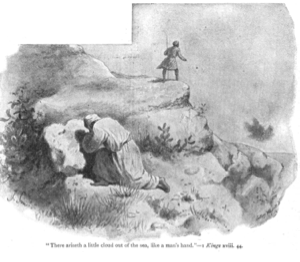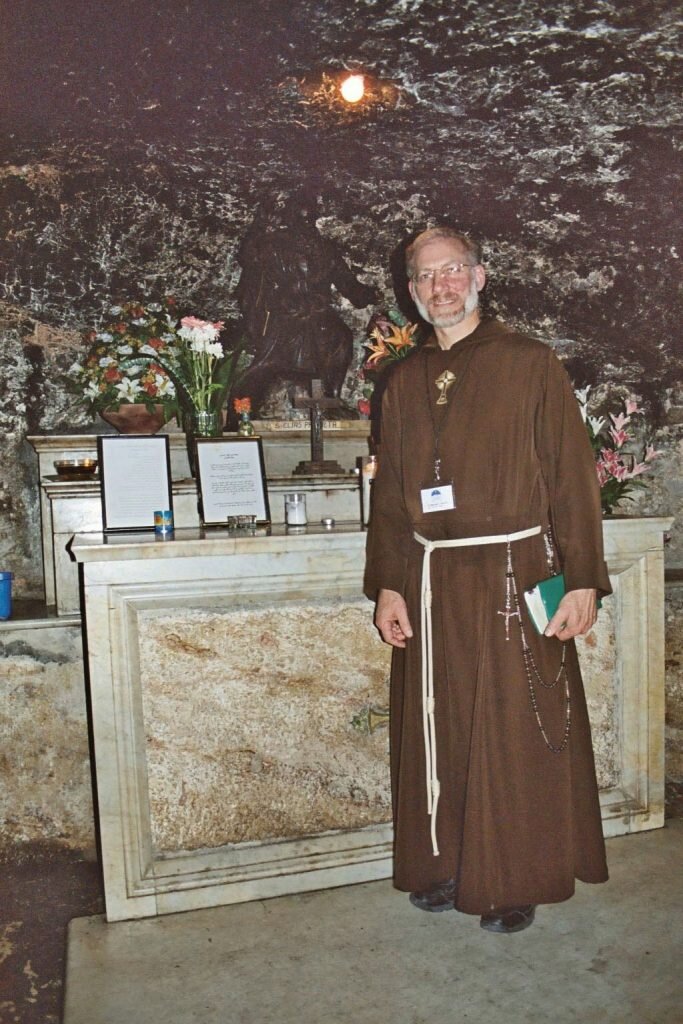Carmelites Visit Mount Carmel, Part II
(Continued from Part I.)
Stella Maris on Mount Carmel
We spent our first two nights in Israel at the Carmelite Pilgrim Center on Mount Carmel.
In the Stella Maris Basilica connected to the guest house, I was happy to see a familiar image of Our Lady of Mount Carmel with the Christ Child and the brown scapular, this time as a large statue carved from cedar of Lebanon above the altar.
Episodes from Carmelite history are painted on the dome, and paintings of Carmelite saints hang above the altars. Colored marble abounds. The dome is supported by marble pillars, the altars are marble flanked by marble columns, and the walls are marble covered.
Star of the Sea, Precursor of the Messiah
I always felt that Stella Maris, Star of the Sea, is one of Our Lady’s most evocative titles. But I only found out while preparing for the pilgrimage how closely this Marian title is related to Carmel.
During the time of Elijah the prophet, the northern kingdom of Israel had suffered years of drought and famine that had fallen in judgement on the land because the wicked Queen Jezebel had led King Ahab and the people of the kingdom into the worship of Baal and Asherath. After Elijah defeated the pagan priests on Mount Carmel as described in 1 Kings, Elijah prophesied to King Ahab that rains would come to break the drought. Even though there was no sign of a storm in the clear sky, Elijah hunkered down in a cave on Mount Carmel to wait for the rain to begin.
A little cloud over the sea from the top of Mount Carmel
Seven times he sent his servant to the top of the mountain look out over the sea, until finally a cloud appeared “as small as a man’s hand.” That little cloud was the precursor of a merciful rain that brought relief to parched and famished Israel. Carmelite tradition holds that Elijah saw the cloud as a prophecy of the coming of Our Lady as the Immaculate Conception. Our Lady herself was understood to be foretold by the cloud to be the immaculately conceived bearer of the Messiah who would bring living water, relief from separation from God, and salvation to the whole world.
The Carmelite Breviary indicates the connection between the Blessed Virgin Mary and Elijah’s little cloud by including in the Office of Readings this reading from the first book of Kings on the Solemnity of Our Lady of Mount Carmel on July 16.
… Elijah climbed to the top of Carmel, crouched down to the earth, and put his head between his knees. “Climb up and look out to sea,” he directed his servant, who went up and looked, but reported, “There is nothing.” Seven times he said, “Go, look again!” And the seventh time the youth reported, “There is a cloud as small as a man’s hand rising from the sea.” … In a trice the sky grew dark with clouds and wind, and heavy rain fell.- Kings 17:42-45
The connection between Our Lady and Mount Carmel and the cloud is indicated again in a hymn from the Ordinary Form Office of Readings for the same day:
Virgin Mary of Mount Carmel
Whom in ancient prophecy
God revealed to Saint Elijah
By an Oriental sea,
Rise again on God’s creation,
Bring to bloom this arid place
With the white cloud of your beauty
And the rainfall of your grace.
In another verse, the hymn calls Our Mother: “Blessed cloud of God’s protection.”
As we learned, the pilgrimage center is high on the mountain, so we got to see for ourselves that Elijah’s servant would indeed have had a clear view of the sea
Elijah’s Cave
Fr. Joseph Mary Wolf in Elijah’s cave
Below the main altar is another altar in a cave. On the altar, placards in many languages explain that this is the cave where Elijah waited for his servant to bring him news of the prophesied rain.
El Muhraka “Place of Burning”
On our first full day together in Israel, the group took a short bus ride to El Muhraka, called the “place of burning,” which also is on Mount Carmel. Tradition says this is the place where Elijah challenged and defeated the prophets of Baal and Asherath and where fire rained down from God to consume Elijah’s offering. A statue of Elijah wielding a sword towered over us in the courtyard. We lingered for a half hour on the roof of the small Carmelite friars’ monastery dedicated to St. Elijah while a guide pointed out the points of interest we could see around us. Because it is on the highest summit of the Carmel Range, the views of Israel and the Mediterranean Sea are even more far-reaching than at Stella Maris.
Father Thomas read us the verses from the first book of Kings Chapter 22 about what happened at El Muhraka.
“Elijah appealed to all the people and said, ‘How long will you straddle the issue? If the LORD is God, follow him; if Baal, follow him.’ The people, however, did not answer him. So Elijah said to the people, ‘I am the only surviving prophet of the LORD, and there are four hundred and fifty prophets of Baal. Give us two young bulls. Let them choose one, cut it into pieces, and place it on the wood, but start no fire. I shall prepare the other and place it on the wood, but shall start no fire. You shall call on the name of your gods, and I will call on the name of the LORD. The God who answers with fire is God.’ All the people answered, ‘Agreed!’
“Elijah then said to the prophets of Baal, ‘Choose one young bull and prepare it first, for there are more of you. Call upon your gods, but do not start the fire.’ Taking the young bull that was turned over to them, they prepared it and called on Baal from morning to noon, saying, ‘Answer us, Baal!’ But there was no sound, and no one answering. And they hopped around the altar they had prepared.
“When it was noon, Elijah taunted them: ‘Call louder, for he is a god and may be meditating, or may have retired, or may be on a journey. Perhaps he is asleep and must be awakened.’ They called out louder and slashed themselves with swords and spears, as was their custom, until blood gushed over them.
“Noon passed and they remained in a prophetic state until the time for offering sacrifice. But there was not a sound; no one answered, and no one was listening.
“Then Elijah said to all the people, ‘Come here to me.’ When they had done so, he repaired the altar of the LORD which had been destroyed. He took twelve stones, for the number of tribes of the sons of Jacob, to whom the LORD had said, ‘Your name shall be Israel.’ He built an altar in honor of the LORD with the stones, and made a trench around the altar large enough for two seahs of grain. When he had arranged the wood, he cut up the young bull and laid it on the wood. ‘Fill four jars with water,’ he said, ‘and pour it over the holocaust and over the wood.’ ‘Do it again,’ he said, and they did it again. ‘Do it a third time,’ he said, and they did it a third time. The water flowed around the altar, and the trench was filled with the water.
“At the time for offering sacrifice, the prophet Elijah came forward and said, ‘LORD, God of Abraham, Isaac, and Israel, let it be known this day that you are God in Israel and that I am your servant and have done all these things by your command. Answer me, LORD! Answer me, that this people may know that you, LORD, are God and that you have brought them back to their senses.’
“The LORD’S fire came down and consumed the holocaust, wood, stones, and dust, and it lapped up the water in the trench. Seeing this, all the people fell prostrate and said, ‘The LORD is God! The LORD is God!’
“Then Elijah said to them, ‘Seize the prophets of Baal. Let none of them escape!’ They were seized, and Elijah had them brought down to the brook Kishon and there he slit their throats.”
Back on the bus, some in the group talked about how the slaughter by Elijah of the prophets was harsh (to put it mildly), but as I later re-read the back story in 1 Kings, I was reminded that Jezebel had previously slain all of the prophets of God (except for Elijah and for 100 others that Ahab’s servant Obadiah had hidden in a cave, and then by the time of the face-off between the competing prophets, Elijah said only he was left). The law of an eye for an eye, a tooth for a tooth (not to mention a prophet for a prophet) seems to have been zealously applied in this case.
(Continued in Part III.)








